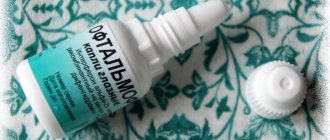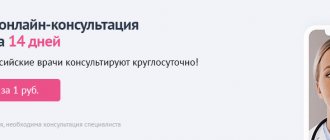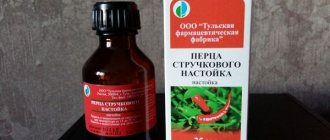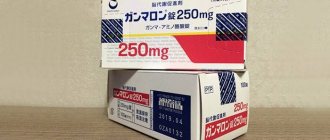Home » Treatment of drug addiction » Treatment of addiction to pharmaceutical drugs » Treatment of addiction to Pentalgin
Pentalgin refers to combination drugs with anti-inflammatory, analgesic and antispasmodic effects. Most often it is used for headaches and toothaches. The active ingredients of the drug are Paracetomol, Naproxen, Caffeine, Drotoverine, Pheniramine Maleate. The release form of the drug is tablets.
Since Pentalgin contains painkillers and psychostimulants, its overdose can cause drug intoxication. Therefore, the medicine must be taken only in recommended doses and according to the schedule specified in the instructions.
How to take Pentalgin tablets
Single dose – 1 tablet. The instructions say that you can take no more than 3 tablets per day. For severe pain, 4 tablets are allowed.
The duration of therapy depends on the condition and is determined individually for each case.
To overcome pain, you can take the medicine for no longer than 5 days. If the drug is taken to reduce fever, then the duration of use should not exceed 3 days. If after this time the symptoms persist, then you need to make an appointment with a specialist. Under no circumstances should you extend the course yourself. It is also impossible to increase the permissible dosage without medical advice.
How Pentalgin works for migraines
Migraines interfere with a person's ability to cope with everyday activities. It appears as a result of narrowing and dilation of blood vessels, which causes ischemia of brain tissue. Pentalgin is able to suppress pain in unbearable headaches. The drug has a rapid analgesic effect due to the presence of paracetamol in the composition. The effect lasts for a long time. The caffeine content helps dilate blood vessels.
On a note! If you have frequent migraines, it is best to consult a doctor.
How Pentalgin helps with muscle pain
After physical exertion, injury and as a result of inflammatory processes, muscle pain may appear. Pentalgin will also help cope with such pain. The tablets help eliminate inflammation, relieve pain and swelling. The analgesic effect lasts for a long time. Thanks to a well-chosen composition, the drug can influence several mechanisms of pain at once. In addition, the tablets have an antipyretic effect and therefore help with high body temperature.
Contraindications
The drug has a large list of contraindications that you should familiarize yourself with before taking it:
- stomach ulcer;
- hemorrhages of the gastrointestinal tract;
- individual susceptibility to the constituent components;
- bronchial asthma;
- kidney and liver diseases in severe form;
- hyperkalemia;
- diseases of the heart and blood vessels;
- persons under 18 years of age;
- period of childbearing and breastfeeding.
If pain of any origin appears, you should initially consult with a specialist who can prescribe the correct treatment.
There are some conditions in which the use of the medication is possible with great caution: high blood sugar, viral hepatitis, epilepsy, elderly patients.
Pentalgin tablets No. 12
Indications
- mild and moderate pain syndrome of various origins (including pain in joints, muscles, radiculitis, algodismenorrhea, neuralgia, headache, migraine, toothache);
- fevers, colds and other diseases accompanied by pain and inflammation.
Directions for use and doses
Pentalgin is taken orally, 1 tablet 1-3 times a day.
The maximum daily dose is 4 tablets.
The duration of treatment is no more than 3 days as an antipyretic and no more than 5 days as an analgesic.
Continuation of treatment with the drug is possible only after consultation with a doctor.
special instructions
Avoid simultaneous use of Pentalgin with other drugs containing paracetamol and/or other non-steroidal anti-inflammatory drugs, as well as with drugs to relieve the symptoms of colds, flu and nasal congestion.
When using the drug for more than 5–7 days, peripheral blood counts and the functional state of the liver should be monitored.
Paracetamol distorts the results of laboratory tests of glucose and uric acid in blood plasma.
If it is necessary to determine 17-ketosteroids, the drug should be discontinued 48 hours before the study. Please note that naproxen increases bleeding time.
The effect of caffeine on the central nervous system depends on the type of nervous system and can be manifested by both excitation and inhibition of higher nervous activity.
During the treatment period you should not drink alcoholic beverages.
In some cases, a decrease in concentration and speed of psychomotor reactions is possible, therefore, during the treatment period, care must be taken when driving vehicles and engaging in other potentially hazardous activities that require increased concentration and speed of psychomotor reactions.
Compound
1 tablet contains: paracetamol 325 mg, naproxen 100 mg, caffeine 50 mg, drotaverine hydrochloride - 40 mg, pheniramine maleate - 10 mg; excipients: microcrystalline cellulose, potato starch, croscarmellose sodium, hyprolose (hydroxypropylcellulose (Klucel EF)), citric acid monohydrate, butylated hydroxytoluene (E 321), magnesium stearate, talc, quinoline yellow dye (E 104), indigo carmine (E 132).
Contraindications
- severe liver failure;
- severe renal failure;
- peptic ulcer of the stomach and duodenum in the acute phase;
- bronchial asthma;
- bronchospasm;
- anemia, leukopenia;
- conditions accompanied by respiratory depression;
- traumatic brain injury;
- severe arterial hypertension;
- acute myocardial infarction;
- arrhythmias;
- alcohol intoxication;
- glaucoma; glucose-6-phosphate dehydrogenase deficiency;
- children under 12 years of age;
- hypersensitivity to the components of the drug.
The drug should be used with caution in mild to moderate arterial hypertension, gastric and/or duodenal ulcers in remission, as well as in elderly patients.
Use during pregnancy and breastfeeding
The use of the drug is contraindicated during pregnancy and lactation (breastfeeding).
Side effects
Allergic reactions: skin rash, itching, urticaria, angioedema;
From the hematopoietic organs: thrombocytopenia, leukopenia, agranulocytosis, anemia, methemoglobinemia;
From the nervous system: agitation, anxiety, increased reflexes, tremor, headache, sleep disturbances, dizziness, decreased concentration;
From the cardiovascular system: palpitations, arrhythmias, increased blood pressure;
From the digestive system: erosive and ulcerative lesions of the gastrointestinal tract, nausea, vomiting, epigastric discomfort, abdominal pain, constipation, impaired liver function;
From the urinary system: impaired renal function;
From the senses: hearing loss, tinnitus, increased intraocular pressure in patients with angle-closure glaucoma;
Other: dermatitis, tachypnea (increased breathing).
Overdose
Symptoms: nausea, vomiting, gastralgia, drowsiness, tachycardia, cardiac arrhythmias, delirium, weakness, respiratory depression.
Treatment: induction of vomiting, gastric lavage through a tube, administration of adsorbents (activated carbon), symptomatic therapy aimed at maintaining vital functions.
Storage conditions
Store in a dry place, protected from light, at a temperature not exceeding 25°C.
Best before date
1 year.
pharmachologic effect
The combined drug has analgesic, antipyretic and anti-inflammatory effects.
Drotaverine - has a myotropic antispasmodic effect due to inhibition of phosphodiesterase IV, acts on smooth muscles in the gastrointestinal tract, biliary tract, genitourinary and vascular systems.
Pheniramine is an H1-histamine receptor blocker. It has an antispasmodic and mild sedative effect, reduces exudation, and also enhances the analgesic effect of paracetamol and naproxen.
Paracetamol is a non-narcotic analgesic that has an antipyretic and analgesic effect due to the blockade of cyclooxygenase in the central nervous system and its effect on the centers of pain and thermoregulation.
Naproxen is a non-steroidal anti-inflammatory drug that has anti-inflammatory, analgesic and antipyretic effects associated with non-selective inhibition of the activity of cyclooxygenase, which regulates the synthesis of prostaglandins.
Caffeine - causes dilation of blood vessels in skeletal muscles, heart, kidneys; increases mental and physical performance, helps eliminate fatigue and drowsiness; increases the permeability of histohematic barriers and increases the bioavailability of non-narcotic analgesics, thereby enhancing the therapeutic effect. It has a tonic effect on the blood vessels of the brain.
Drug interactions
With the simultaneous use of drugs that have a depressant effect on the central nervous system (including sedatives and tranquilizers), the severity of the sedative effect and inhibitory effect on the respiratory center is likely to increase.
Strengthens the effect of ethanol on the psychomotor reaction. Metamizole sodium reduces the concentration of cyclosporine. Metamizole sodium, displacing oral hypoglycemic drugs, indirect anticoagulants, glucocorticosteroids and indomethacin from protein binding, increases their activity.
Tricyclic antidepressants, oral contraceptives, and allopurinol disrupt the metabolism of metamizole in the liver and increase its toxicity.
Concomitant use of the drug with other non-narcotic analgesics may lead to increased toxic effects.
Barbiturates, phenylbutazone and other inducers of microsomal liver enzymes weaken the effect of metamizole.
Adverse reactions and overdose
While taking the drug, negative reactions may appear in the form of allergies, problems with the nervous and digestive systems, and disruption of the cardiovascular system. The following symptoms are typical for such conditions: skin rash, hives, feelings of excitement and anxiety, disturbed sleep, rapid heart rate, high blood pressure, nausea, vomiting, upset stomach, dizziness.
If you use tablets in large quantities for a long time, an overdose may occur. It is manifested by the following symptoms: pale skin, anorexia, pain in the abdomen, vomiting, nausea, nervous and restless state, confused thinking, rapid pulse, pain in the head.
In rare cases, more serious symptoms and problems may occur: arrhythmia, pancreatitis, death.
If undesirable reactions occur, you should immediately rinse the stomach, take activated charcoal, and begin symptomatic treatment.
Action from Pentalgin
In therapeutic doses, Pentalgin is safe for the patient. But even so, its use must be careful.
Possible side effects:
- allergic reactions;
- leukopenia;
- anemia;
- increased excitability;
- anxiety;
- insomnia;
- arrhythmia;
- nausea;
- stomach ache;
- noise in ears.
This is not a complete list of the negative manifestations of Pentalgin. If such symptoms appear, it is necessary to replace the medicine with another drug. An overdose of Pentalgin is especially dangerous, causing euphoria and hallucinations in a person. This effect is used by drug addicts, immersing their consciousness in an illusory world. But colorful pictures are replaced by severe withdrawal symptoms and chronic diseases.
Don't know where to start? Call us, we will tell you
8 Call back
special instructions
Shelf life – 24 months. Should be kept in a dark and dry place at room temperature.
The drug has a number of proven analogues. These include: Ibuprofen, Amizon, Paracetamol. Before making a replacement, you need to consult a specialist.
Concomitant use of the drug with other drugs that contain paracetamol and NSAIDs is not allowed.
If the patient takes the medicine for more than a week, then it is necessary to monitor the value of peripheral blood and liver function.
Since caffeine is present in the composition, it can affect the nervous system, having an stimulating or, on the contrary, inhibitory effect.
Treatment of addiction to Pentalgin
At the initial stage of development of dependence on Pentalgin, you can get by with outpatient treatment. But advanced cases of using pharmaceutical psychostimulants for non-therapeutic purposes are recommended to be treated in a hospital in a specialized medical institution.
The drug treatment clinic “New World” offers its services in organizing the treatment of drug addiction to Pentalgin and other medications. We have everything to save the patient and return him to a healthy lifestyle. The main thing is to be motivated to give up drugs completely and start collaborating with doctors.
Therapeutic measures are carried out in several stages:
- Diagnosis of health status.
- Detoxification of the body.
- Rehabilitation using medicinal methods.
- Psychotherapy.
- Social adaptation.
- Prevention of breakdown.
If the patient follows all the doctors’ recommendations, you can be sure of a positive treatment result. For all questions related to drug addiction therapy and conditions of medical care, please contact us by phone.







